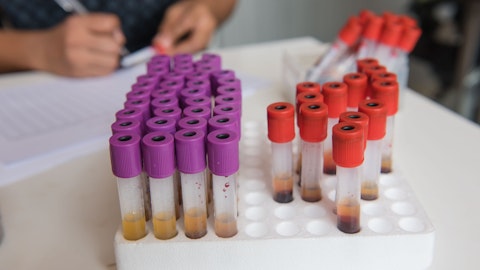Stephen Schwartz: Yes. I mean, maybe I’ll step back and talk about it from an Azenta point of view. If you look at the Azenta business and you exclude B Medical for the dynamics that we talked about, and you have Q1, you have the Q2 guide and you have the book end of the full year guide what you’ll see, and it’s just math, is that it’s a very balanced business overall. If you look at the mix of revenue in the first half versus the mix of revenue in the second half, it’s very balanced. And if you look at the growth rates from the first half to the second half, it’s very balanced. So I think you have similar dynamics in C&I, Andrew, it’s a — I wouldn’t look at that business as being overly cyclical. And Azenta overall, when you unpack the SMS business and also the Multiomics business, you see really a nice balance across the first half and second half.
Andrew Cooper: Great. Looking forward to seeing everybody in March. Appreciate it.
Operator: Your next question comes from the line of Paul Knight with KeyBanc. Your line is open.
Paul Knight: Yes. Where are you with the transition on your, just your sales distribution model? I know you had to redo that strategy. So are you half done — where you — where you need to be?
Stephen Schwartz: Paul, thanks. We’re aligned. So we have the sales organization is complete. In each of the three segments, there is a dedicated sales organization. And now it’s just getting traction in practice and making sure that we execute. But we believe the fact that we’ve been growing in this environment is because we’ve got the sales aligned again as it should be. So distribution channel continues to build. And you can imagine as we exercise that channel, we’ll be rotating through different distributors who are keeping up, but we like how the channel has built and the scientists — selling to scientists in Multiomics business is already completely aligned. We still have some openings to fill. But by and large, that organization is also in place, and that’s why we’re seeing, we’re starting to see really good traction.
Paul Knight: And then could you update us on China? I know you had, you re-did logistics a little bit there last year. Capacity expansion and [indiscernible]? Thanks.
Stephen Schwartz: You bet. And so let me talk to China a little bit. So we mentioned that we were double-digit growth in China again for the third consecutive quarter. Most of the business we do in China these days is Services related. So it’s for the Multiomics business. And we grew 11% in synthesis this quarter again. So we’ve seen strong growth in synthesis, really good recovery the issues we had in China 18 months ago are behind us, and we feel like we’re in a really good position back to growth. I can tell you, the team is incredibly busy in China, serving the customers both inside and outside of China. So we believe China is fully capable, full speed ahead and just the growth characteristics they’ve exhibited so different from what’s going on in the rest of the market, is attributed to a strong team aggressively going after all their local customer base.
Paul Knight: And then lastly, on B Medical. I mean, I thought the real reason to buy B medical was to move it into things to size vaccine. The technology in the box was kind of what you liked a lot and maybe move into other areas like Service. Where are you in that journey with B Medical?
Stephen Schwartz: Yes. Paul, it’s exactly what the DRC contract is about. That’s the probably the most exciting opportunity for us. We talked about the €60 million portion of the €100 million agreement is related to vaccine cold chain. But the DRC, Toyota, Azenta, B Medical, we’re all focused on how to use those now do whole blood recovery. So the plans are for how do we get to retrieving a million whole sample, whole blood samples per year in the DRC through this channel using the B medical vaccine boxes on outbound side sample retrieval on the inbound. And those are the active live discussions that are going on right now because it is a top priority for the Ministry of Health. And that’s exactly where we are. And that’s why we’re really enthusiastic about the DRC.
We hope before the year is over, that we can articulate what that program is specifically with numbers and units and samples in terms of what that’s done from a transformative standpoint to add tremendous value to a product-based B medical vaccine cold chain to Services revenue for Azenta on the sample retrieval side.
Paul Knight: Thank you.
Operator: Your next question comes from the line of Vijay Kumar with Evercore ISI. Your line is open.
Stephen Schwartz: Hey, Vijay.
Vijay Kumar: Hi Steve. Thanks for taking my question. Just maybe a few if you don’t mind. Few questions on guidance. Second quarter mid-single to high singles. Is that like total revenue growth? Or is that an organic number, if you could clarify?
Stephen Schwartz: That’s going to be an organic number.
Vijay Kumar: Fantastic. And I think based on those numbers, they implied from back half as high teens, the step-up in the back half, what are you assuming? Is that all just coming from B Medical and DRC contract revenue recognition? Or are you assuming Sample Management and Multiomics to step up in the back half?
Herman Cueto: So Vijay, it’s Herman. So when you, so when you look at the business x B Medical for a minute, if you look at the Q1 actuals and you now have the color on Q2 and you have the full year guide is the book end. What you’ll see is a very balanced mix of revenue between the first half and the second half. And you can do the math, it’s around 49-51, and you look at the growth rates, again, they’re very, very balanced. So when you look at SMS and Multiomics between the first half and second half, you don’t have very large step-ups. It’s not a hockey stick. The big piece is B Medical in the back half, and that becomes all about the pipeline conversion. We have a very robust pipeline. The timing of when it converts is the thing that we’ve been talking about for the last two quarters.
Stephen Schwartz: So Vijay, this is Steve. I think you hit it exactly. We have good line of sight, good visibility to the business on the Multiomics side on the SMS side. We feel really comfortable about what that looks like and Herman defined the progress, it’s a modest uptick from the first half to the second half, and we feel good about that. And we had a lot of good opportunity there. It’s heavily weighted on bringing the B Medical business home in the second half.
Vijay Kumar: Understood. And then one on NGS here’s modest growth. Is that just making the transition because of price coming down, like can this business get back like high singes? Like how do you see NGS market playing out?
Stephen Schwartz: So Vijay, what we see, again, we need a few more data points, but the number of reactions we ran was up considerably, but we prepared for it. We knew this was coming. But we’re starting to populate with a large number now of the NovaSeq X Pluses and it does change the economics. So we’re comfortable to help pass the reagent costs through the customers. But we still get paid for the value that we bring for the consultative nature of what we do for the capital that we’ve employed. And so that’s why we can sustain the margin while we’re growing revenue. It’s, the amount of work we’re doing is up significantly. We’re going to work to stay in front of it. So I’m guessing that we’ll ask each other this question 1 quarter now and 2 quarters now, 3 quarters from now, just to make sure that we’re keeping up.
But right now, that’s how this is playing out. We’re able to sustain margin right now, but we are, we’re putting a lot of volume through brand new tools, and we think that transition will just keep coming.
Vijay Kumar: Understood. And maybe my last one’s Herman for you. The interest income assumption here for 2Q is that just because of lower cash balance on share repurchase? And then the free cash flow performance in Q1 are pretty impressive. Is that sustainable? I think it’s annualizing to $60 million?
Herman Cueto: Yes. So maybe the first one on the interest income. So we do see a little bit of uptick in interest income in the second quarter, and we’re calling that out. And again, it’s just, it’s more around the timing of the cash that we’re holding. And then free cash flow, yes, we feel good about where cash flow is coming in. We’re doing a lot of work operationally, a lot of discipline around spend management, timing, working capital. So I don’t want to speculate on where the number could go, but your math is right, 15 times 4 is 60. So yes, we’ll see where it ends up.
Vijay Kumar: Fantastic. Thanks guys.
Herman Cueto: Thanks Vijay.
Operator: And your next question comes from the line of Yuan Zhi with B. Riley. Your line is open.
Yuan Zhi: Thank you for taking my questions. First, we are trying to best understand the impact from recent news from [indiscernible] bankruptcy. Are the clients of the firm? And is there any read-through to your Genomics customers in this clinical application space?
Stephen Schwartz: Yes, Yuan, not yet. I mean we, this isn’t so immediate, and we’ve got other backup capabilities we provide to customers. So we think we’re, we think there’s no repercussions that we haven’t guided or people aren’t aware of.
Yuan Zhi: Another question is for AstraZeneca, as it announced it’s $300 million sales therapy project here in Maryland for cell therapy manufacturing. Can you maybe comment for projects like this, what is the impact to different parts of Azenta business, the Large Stores, the Sample Management and maybe some Genomics? And if you can win some business here?
Stephen Schwartz: Yes, Yuan, it’s not something we’re able to comment on specifically for a customer. But you can imagine anywhere there’s an opportunity like this that we’re involved. So we can’t be specific, but, we’ve been partners with AstraZeneca for many, many years.
Yuan Zhi: Got it. That’s all from my end. Thank you.
Stephen Schwartz: Thanks Yuan.
Operator: There are no further questions. I’ll turn the call back to your presenters for closing remarks. Thank you very much.
Stephen Schwartz: Okay. Thank you, everybody, for joining the call today, and a big thank you to the 3,500-plus Azenta associates around the world. Thank you very much.
Herman Cueto: We look forward to speaking with you at the Analyst Day on the 14th of March. Thanks, everyone.
Operator: That does conclude the conference call for today. We thank you very much for your participation. You may now disconnect.
Follow Azenta Inc. (NASDAQ:AZTA)
Follow Azenta Inc. (NASDAQ:AZTA)
Receive real-time insider trading and news alerts




